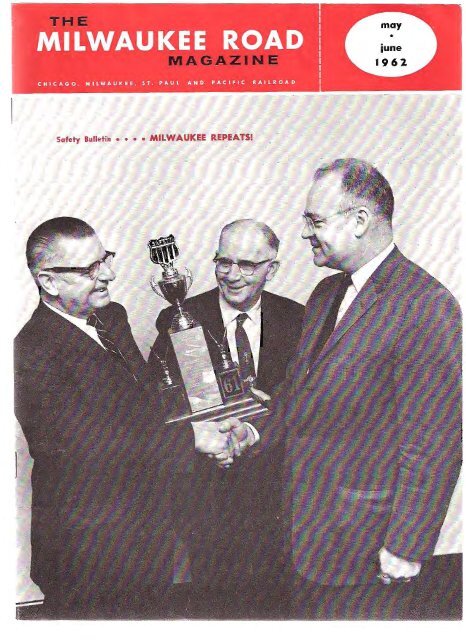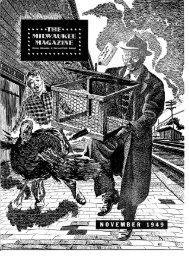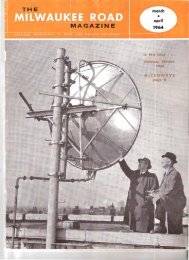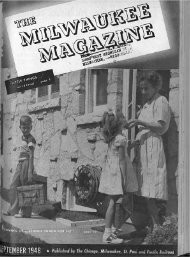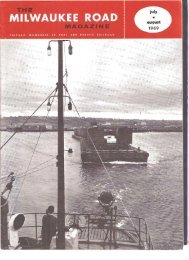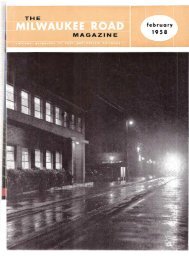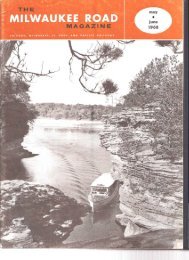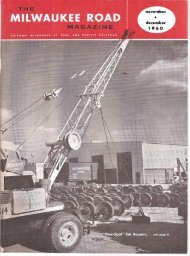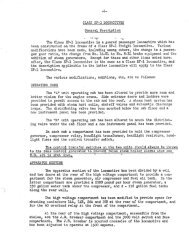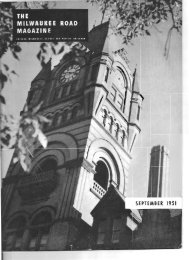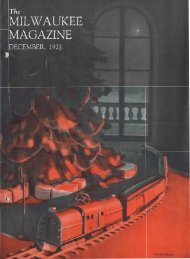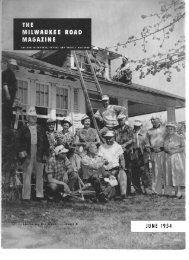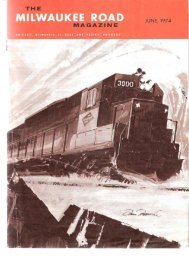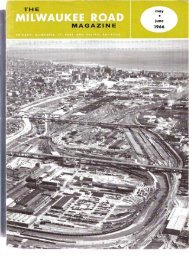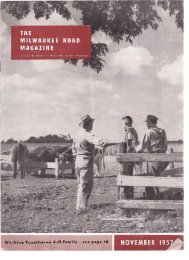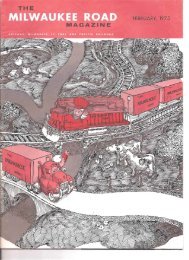May-June 1962 - Milwaukee Road Archive
May-June 1962 - Milwaukee Road Archive
May-June 1962 - Milwaukee Road Archive
You also want an ePaper? Increase the reach of your titles
YUMPU automatically turns print PDFs into web optimized ePapers that Google loves.
· <br />
Safety Bulletin • • • • MILWAUKEE REPEATS!
SAFETY BULLETIN:<br />
... MILWAUKEE REPEATS!<br />
Terminals Employes Win<br />
THE persistence which has marked the<br />
effort of the <strong>Milwaukee</strong> Terminals employes<br />
to win the annual safety contest<br />
was highlighted at a ceremony in <strong>Milwaukee</strong>,<br />
Wis., on Apr. 27 which acknowledged<br />
their 1961 standing as the<br />
best among the <strong>Road</strong>'s 12 operating divisions<br />
..<br />
Recognition of their achievement took<br />
into account that the <strong>Milwaukee</strong> Terminals<br />
Division had also won the President's<br />
Safety Cup last year for the first<br />
place finish in 1960.<br />
The 1961 trophy, of a new design,<br />
was presented to the employes, including<br />
<strong>Milwaukee</strong> Shops people, lily L. V. Anderson,<br />
general manager system, and<br />
accepted on their behalf by J. J. Dombrowski,<br />
superintendent of the <strong>Milwaukee</strong><br />
Terminals. The occasion included<br />
congratulations to Mr. Dombrowski and<br />
to F. J. Ladwig, district safety engineer,<br />
for working hand in hand toward the<br />
success of the safety program.<br />
Acting as master of ceremonies. J. A.<br />
System Safety Contest<br />
Jakubec, assistant to vice president-operation,<br />
presided at the event, which waS<br />
attended by G. L. Wood, general superintendent<br />
of the car department; A. W.<br />
Hallenberg, general superintendent motive<br />
power; J. D. Shea, general superintendent,<br />
<strong>Milwaukee</strong>; and G. M. Dempsey,<br />
assistant superintendent of safety.<br />
Speakers, in addition to Mr. Anderson<br />
and Mr. Dombrowski, included A. W.<br />
Shea, superintendent of safety; F. A.<br />
Upton, chief mechanical officer; and R.<br />
K. Baker, assistant general storekeeper.<br />
The division and shops employes won<br />
the contest with a total of 4,637,258<br />
man hours worked without a fatality,<br />
and only 27 reportable injuries, with a<br />
resulting casualty rate of 5.82. Second<br />
honors were won by the Iowa Division<br />
with a rate of 6.78, and third place went<br />
to the Rocky Mountain Division, which<br />
rated 7.76.<br />
The fact that during 1961 the <strong>Milwaukee</strong><br />
T e r min a Js Division had the<br />
greatest number of employes with the<br />
The President's Safety Trophy is presented to employes of the <strong>Milwaukee</strong> Terminals<br />
Division, safest on the railroad in 1961. Participating in the presentation ceremony<br />
are, from left; G. M. Dempsey, assistant superintendent of safety; F. J. ladwig, district<br />
safety engineer, <strong>Milwaukee</strong>; A. W. Shea, superintendent of safety; l. V. Anderson,<br />
general manager system; J. J. Dombrowski, superintendent of the terminals; and<br />
J. A. Jakubec, assistant to vice president-operation.<br />
4<br />
Superintendent J. J. Dombrowski has<br />
something to smile about.<br />
greatest number of man hours worked<br />
compared with all other divisions of the<br />
railroad made the record particularly<br />
laudable. This was emphasized by Mr.<br />
Shea, who cited the winning of the contest<br />
two years in succession as indicative<br />
of the fine spirit of cooperation which<br />
exists between employes and supervisors,<br />
and the interest of the individual employe<br />
in his personal safety.<br />
Contest a Challenge<br />
The annual safety contest has represented<br />
a challenge to <strong>Milwaukee</strong> Terminals<br />
employes ever since the competition<br />
was started among the operating<br />
divisions in 1941. A runner-up in both<br />
1958 and 1959, its victory in the 1960<br />
contest was commended for dogged effort.<br />
By posting the winning score again<br />
in 1961 it became the second terminal<br />
division on the system to win the trophy<br />
two years hand running. Only the Twin<br />
City Terminals has a comparable record<br />
(accomplished in 1950-51).<br />
In accepting the trophy, Mr. Dombrowski<br />
said that it reflected credit on<br />
every employe on the division; that<br />
without sharp-eyed attention to sound<br />
principles of safety laid down for their<br />
protection the performance would not<br />
have been possible. At the same time he<br />
pointed out that the safety job can never<br />
be considered finished. "Let's all do our<br />
part," he said, "to win again this year;<br />
to set a new mark for the contest."<br />
That the accomplishment was a<br />
major one was stated a1so by Mr. Anderson,<br />
who said, "In achieving this record<br />
you have .?one something not alone<br />
for yourselves and for your families, but<br />
you have done a service to the <strong>Milwaukee</strong><br />
<strong>Road</strong> by saying, in effect, to the peo.<br />
The <strong>Milwaukee</strong> <strong>Road</strong> Magazine
pIe of this area that the <strong>Milwaukee</strong> is a<br />
railroad whose employes take a heads-up<br />
intelligent view of their work.<br />
"I am inclined to agree with the man<br />
who said that the one shortcoming of<br />
which a person can never be cured is indifference.<br />
Believe me when I say I am<br />
certainly happy that <strong>Milwaukee</strong> <strong>Road</strong><br />
people in the <strong>Milwaukee</strong> Terminals and<br />
at the shops are not indifferent to the<br />
importance of safety ... This is not the<br />
time in the history of the railroads for<br />
anyone to be indifferent ... not if he<br />
wants to be sure that the industry and<br />
his own railroad can meet the competition<br />
and remain vigorous and dependable<br />
as an employer.<br />
"The railroads need the support and<br />
the conscientious efforts of all railroad<br />
people today, and I know of no way in<br />
which that support is more truly displayed<br />
than in a good safety record such<br />
as you have created."<br />
Rank<br />
1<br />
2<br />
3<br />
4<br />
--<br />
5<br />
-_.<br />
6<br />
-<br />
7<br />
8<br />
9<br />
10<br />
11<br />
12<br />
1961 STANDINGS IN PRESIDENT'S SAFETY TROPHY CONTEST<br />
CASUALTIES Casualty<br />
Division Fatal Reportable Injuries Rate<br />
<strong>Milwaukee</strong> Terminals<br />
(including <strong>Milwaukee</strong> Shops<br />
- 27 5.82<br />
Iowa<br />
- I 12 6:78<br />
Rocky Mountain<br />
- 14 7:76<br />
Aberdeen<br />
LaCrosse<br />
Twin City Terminals<br />
Chicago Terminals<br />
Coast<br />
Terre Haute<br />
<strong>Milwaukee</strong><br />
Dubuque & Illinois<br />
Iowa Minn. & Dakota<br />
Others<br />
SYSTEM TOTALS<br />
COMMENTS FROM OUR CUSTOMERS<br />
"The most a,g1'eeable l'ecompense wh1:ch we can<br />
receive for things wh'ich we have done is to see<br />
them knolvn, to have them applauded with pra-ises<br />
wh-ich hanOI' l£S.))<br />
-:Moliere<br />
MILLION $$ DREAM-LIVING ON A TRAIN<br />
"My children and I traveled to California<br />
and returned on the City of Los Angeles .. ,<br />
We want to tell you how much we enjoyed<br />
our trip and how very nice everyone connected<br />
with the railroad and the Pullman<br />
Company was to us, The people in the station<br />
at Marion and East 1. A. were so helpful<br />
and courteous.<br />
"We were lucky in going and returning<br />
with the same conductor, porters, steward,<br />
waiters, etc., and they were all so friendly<br />
and nice that we felt very much at home .. ,<br />
In fact, we had such fun, we have decided<br />
that if we ever happen to inherit a million<br />
or two we will spend a few years just living<br />
on the train!"<br />
Mrs, Fred Corey<br />
Cedar Rapids, la,<br />
A CREDIT TO OUR CORPORATION<br />
..... During a severe snowstorm my airline<br />
flight to the West Coast was cancelled,<br />
along with that of three of my companionswe<br />
were all headed for San Francisco for a<br />
very important meeting.<br />
"We arrived at the Union Station [Chicago]-as<br />
you can imagine, quite desperatetrying<br />
to find a way to San Francisco, and<br />
were making little headway until we met<br />
William H. Stiyer, the station passenger<br />
agent . . . We told him our problem, he<br />
analyzed possibilities . . . and then pro<br />
<strong>May</strong>-<strong>June</strong>, <strong>1962</strong><br />
ceeded to find some method for us to make<br />
connections; even went so far as to contact<br />
St. Paul to see if flight conditions were<br />
sufficiently good so that by taking a train<br />
we could pick up a plane there. to get us to<br />
San Francisco on time.<br />
"The purpose of this letter is to let you<br />
know that people appreciate effort beyond<br />
the caJI of duty. Mr. Stiyer, in my opinion,<br />
is certainly a credit to your corporation in<br />
that he arose to a situation which could have<br />
been very easily ignored, and made four<br />
devoted friends for The <strong>Milwaukee</strong> <strong>Road</strong>."<br />
George H. Fezell<br />
Chicago, Ill.<br />
IN GOOD HANDS<br />
"I inadvertently left a clothing bag on a<br />
suburban train one morning and realized I<br />
had done so jusr as the train was being<br />
pulled out of the station. I went to the office<br />
of S. C. Pulford, trainmaster [Chicago<br />
Terminals], who made a number of phone<br />
calls to. . request your personnel in the<br />
Western Avenue yards to find the car and<br />
determine if the bag was rhere.<br />
"I made two telephone calls after that to<br />
Mr. Pulford's office, and talked with Mr.<br />
Culliton [yardmaster] who was following<br />
through and checking possible sources. Fortunately,<br />
the bag was returned abour noon<br />
to the Lost and Found room.<br />
My relations with your railroad<br />
have been unusually close and pleasant ...<br />
- 14 9.16<br />
1 24 9.41<br />
----_.<br />
- 24 10.41<br />
- 50 11.68<br />
- 28 12.22<br />
- 8 12.31<br />
- 28 12.33<br />
-<br />
-----<br />
32 12.41<br />
1 27 13.59<br />
-<br />
2 I<br />
34<br />
322<br />
5.38<br />
9.22<br />
My grandfather, Walter L. Webb, served as<br />
division engineer for your road for both the<br />
Savanna and the Chicago area ... and my<br />
father owns a business adjoining your tracks<br />
ar the Elgin station which was started by my<br />
great grandfather some 83 years ago, much<br />
of which has been located on real estate<br />
leased from the <strong>Milwaukee</strong> <strong>Road</strong> throughout<br />
the entire period, Therefore, I am particularly<br />
happy to find the present operation of<br />
the railroad in the hands of men such as Mr.<br />
Pulford and Mr. Cullirnn."<br />
William W. Brady<br />
Elgin, Ill.<br />
FOR INTEREST IN SCOUTING<br />
"Last fall my son Mark received a package<br />
of literature from you for his Cub Scout scrapbook.<br />
I would like to add my thanks along<br />
with his.<br />
"Thanks to your interest in youth, Mark<br />
will receive an exrra Silver Arrow, because his<br />
scrapbook is so fifle. Needless to say, he is<br />
very proud, and we both agree with your<br />
title of 'The Friendly Railroad of the Friendly<br />
West'."<br />
Mrs. Naida Kuhr<br />
St. MarYJ, Ohio<br />
CONSISTENTLY COURTEOUS<br />
"The buyers and executives of our store<br />
have been traveling on the <strong>Milwaukee</strong> <strong>Road</strong><br />
extensively, and I wish to express our appreciation<br />
for the fine service rendered. Me.<br />
Tomlinson, one of your ticket agents ifl<br />
MadisIDn [Ticket Seller C. H. Tomlinson],<br />
has been most helpful and courteous. I have<br />
watched this man wait on people from all<br />
walks of life, and he displays the same<br />
courteous attitude to alL"<br />
Alex J. 'Cochrane, PreJident<br />
Olson and VeerhuJell<br />
.MadiJol1, Wis,<br />
5
President Quinn Comments On:<br />
Railroading In the Space Age<br />
WITH regard to the place of surface<br />
transportation in the space age, President<br />
William J. Quinn told members of the<br />
American Railway Development Association<br />
in Minneapolis <strong>May</strong> 14 that the<br />
railroads are not waiting for business to<br />
come their way, but are devising methods<br />
to meet the new needs with much<br />
the same creativity and imagination that<br />
characterizes the space program itself.<br />
He cited the <strong>Milwaukee</strong> <strong>Road</strong>'s integrated<br />
rail-truck service to missile base<br />
projects as an· illustration, and called attention<br />
to piggyback, Flexi-Van, tri-Ievel<br />
automobile carrying cars and other new<br />
types of rail equipment as being indicative<br />
of significant changes in the "physi<br />
qualifying conditions stipulated by the<br />
<strong>Milwaukee</strong> included the state commissions<br />
or Washington, Oregon, Wisconsin,<br />
Michigan and Iowa. Department of<br />
Justice witnesses also testified to the<br />
harmful effects of unconditioned merger,<br />
stating that they favored greater, rather<br />
than less, competition between the applicant<br />
lines and other railroads in the<br />
area involved,<br />
A proposal made by Oregon Public<br />
Utility Commissioner Jonel C. Hill at<br />
the session in Portland Mar. 22 was reopened<br />
at the Chicago hearing. The<br />
plan is keyed to withholding the Spokane,<br />
Portland & Seattle Railroad from<br />
the merger and allowing the <strong>Milwaukee</strong><br />
<strong>Road</strong> to acquire ownership. It would<br />
also provide the <strong>Milwaukee</strong> <strong>Road</strong> with<br />
trackage rights over the Oregon Electric<br />
Co. lines to Eugene.<br />
In connection with the proposal, R.<br />
K. Merrill, commerce counsel for the<br />
<strong>Milwaukee</strong> <strong>Road</strong>, stated at the Chicago<br />
hearing that the <strong>Milwaukee</strong> had not contemplated<br />
the move, but if the state and<br />
the Interstate Commerce Commission<br />
feel it in the public interest that a study<br />
should be made to determine its feasibility,<br />
the <strong>Milwaukee</strong> would cooperate in<br />
such a study.<br />
Testimony on the merger application<br />
is winding up in <strong>June</strong> with hearings in<br />
Fargo and Bismarck, N. D., Missoula,<br />
Helena, Great FaUs, and Billings, Mont.,<br />
Aberdeen, S. D., and in Minneapolis<br />
starting <strong>June</strong> 27. Before it is concluded<br />
some 600 witnesses will have testified.<br />
<strong>May</strong>-<strong>June</strong>, 7962<br />
cal forms of transportation."<br />
In addressing the 53rd annual dinner<br />
meeting of the railway development<br />
group, Mr. Quinn said that the public<br />
looks to the nation's industry, including<br />
the railroads, to maintain America's<br />
ability to compete in the world of space<br />
-to surpass Russia. "Big business must<br />
understand the national purpose", he<br />
said, "and business leaders must prepare<br />
to meet the challenge."<br />
Mr. Quinn observed that perhaps<br />
what is needed is a rediscovery of the old<br />
truth that "productivity" is not a physical,<br />
but an economic term. With relation<br />
to the transportation industry, he said,<br />
"What determines productivity for the<br />
railroads is not how many carloads we<br />
handle, but how much economic value to<br />
the shipper our enterprise provides-and<br />
important among our shippers are those<br />
currently contributing to the space age<br />
program."<br />
Mr. Quinn pointed out that today, in<br />
the space age, the railroads are still the<br />
"work horse" of transportation. "Space<br />
capsules, missiles, the thousands of<br />
pieces of equipment designed to project<br />
them through space, the delivery of material<br />
for the construction of launching<br />
President William J. Quinn (center) inspecting<br />
samples of newly developed<br />
wheat products with L. B. Horton, commissioner<br />
of agricultural and mineral<br />
development (right), and D. G. Fletcher,<br />
executive vice president of the Crop<br />
Quality Council, Minneapolis. Mr. Horton,<br />
president of the American Railway Development<br />
Association, presided at the<br />
53rd annual dinner.<br />
sites-all are dependent on the reliable,<br />
low-cost services of the railroads."<br />
Remarking that changes which used to<br />
take generations now occur in a few<br />
years-even overnight, he said, "We<br />
should bear in mind that the space age<br />
is not an isolated phenomenon, but the<br />
logical outgrowth of our having successfully<br />
joined scientific, mechanical and in<br />
'dustrial progress to create a productive<br />
complex such as the world hardly<br />
dreamed of a generation ago."<br />
(Continued on page 12)<br />
<strong>Milwaukee</strong> <strong>Road</strong> personnel who attended the dinner meeting at which President<br />
William J. Quinn (seated, center) was the principal speaker. Seated, from left: G. A.<br />
Dyke, agricultural agent, Spokane; E. J. Stoll, director-real estate and industrial<br />
development; L. B. Horton, commissioner of agricultural and mineral development;<br />
and F. J. Kuklinski, superintendent, Twin City Terminals. Standing, from left: J. F.<br />
Grier, western director-industrial and real estate development, Seattle; A. G. Claflin,<br />
agricultural agent, Aberdeen, S. D.; T. A. Hunt, industrial engineer, and J. V. Kelly,<br />
geologist, both of Chicago; S. P. Elms(ie, general agent, and M. M. Wolverton, assistant<br />
traffic manager, both of Minneapolis; P. Braun, general agent, St. Paul; D..W.<br />
Spencer, grain marketing representative, Minneapolis; G. Orrben, tNminal manager,<br />
<strong>Milwaukee</strong> Motor Transportation Company, Twin Cities; and S. J. Oberhauser,<br />
agricultural agent, Minneapolis.<br />
7
A scene at the display of the<br />
oldest and newest PS-1 box<br />
cars. The difference between<br />
the models reflects the progress<br />
made in the past 15<br />
years of freight car development,<br />
as railroads and their<br />
suppliers cooperated to meet<br />
expanding service demands.<br />
GOLD BOX CAR for the MILWAUKEE<br />
A PRODUCTION milestone in railroad<br />
carbuilding of import to the <strong>Milwaukee</strong><br />
<strong>Road</strong> was observed at the Pullman<br />
Standard plant in Michigan City, Ind.,<br />
Apr. 10 when a golden box car bearing<br />
the <strong>Milwaukee</strong>'s trade mark rolled off<br />
the assembly line.<br />
The glittering finish which set MILW<br />
2150 apart from its look-alikes symbolized<br />
the building of the 100,00Oth PS-1<br />
Pullman Standard box car under a standardization<br />
program begun in 1947. By<br />
chance, the car was part of a purchase<br />
order for 605 freight cars of various<br />
types nearing completion for the <strong>Milwaukee</strong>.<br />
To commemorate the occasion,<br />
the newest of the series was exhibited<br />
alongside the first PS-l.<br />
A highlight of the ceremonies, attended<br />
by <strong>Milwaukee</strong> <strong>Road</strong> officers and<br />
Michigan City civic leaders, was the<br />
presentation to President William J.<br />
Quinn of a scale model of the gold<br />
painted car by Pullman-Standard President<br />
John W. Scallan. Mr. Quinn also<br />
received a key to the city from the<br />
Michigan City chamber of commerce, as<br />
an expression of gratitude for <strong>Milwaukee</strong><br />
<strong>Road</strong> business in that community.<br />
In accepting the tokens, Mr. Quinn<br />
commented on the extent of the changes<br />
which have taken place in the transportation<br />
field, observing .that the many<br />
differences between the first PS-l box<br />
car and the one delivered to the Milwau<br />
8<br />
Pullman Standard's 100;OOOth PS-l<br />
kee were indicative of the transition.<br />
"Those changes," he said, "demonstrate<br />
the fact that the railroads' shippers<br />
are demanding and getting freight handling<br />
equipment tailored to their requirements."<br />
He also noted that the interest shown<br />
by the business community of Michigan<br />
City in the exhibition of the 100,000th<br />
PS-l box car was illustrative of the importance<br />
of railroads and the railroad<br />
supply industry to the economy of the<br />
entire country.<br />
The development of the PS-1, based<br />
on Pullman's idea of fabricating parts<br />
in its own shops and standardizing components,<br />
was a departure from existing<br />
carbuilding methods. As a result of<br />
technological advances and service de-<br />
The scale model of the gold painted box<br />
car being presented to President William<br />
J. Quinn at the Pullman-Standard plant<br />
in Michigan City, Ind. Shown alongside<br />
the prototype are, from left: George L.<br />
Green, Pullman-Standard vice president<br />
in charge of marketing; John W. Scallon,<br />
president of that company; Mr. Quinn;<br />
and V. E. McCoy, chief purchasing officer<br />
of the <strong>Milwaukee</strong> <strong>Road</strong>. On the step are,<br />
left to right: the <strong>Milwaukee</strong>'s F. A. Upton,<br />
chief mechanical officer; F. G. Mc<br />
Ginn, vice president-operation; and F. W.<br />
Bunce, recently retired chief mechanical<br />
officer.<br />
mands, today:s box car is 10 feet longer<br />
and 2 inches wider than the first one<br />
built in 1947. Other improvements include<br />
side door openings two feet wider,<br />
roller bearings, a nailable steel floor instead<br />
of wood, and side lining equipped<br />
with rails in which load retaining crossbars<br />
can be anchored. Capacity has increased<br />
from 100,000 pounds to 135,000<br />
pounds.<br />
MILW 2150 is one of a special group<br />
which features the Hydroframe-60 cushioned<br />
underframe. This device, designed<br />
to control damage to fragile freight<br />
The <strong>Milwaukee</strong> <strong>Road</strong> Magazine
President William J. Quinn receives a<br />
key to the city from the Michigan City<br />
(Ind.l chamber of commerce, presented<br />
by John Garrettson, vice president of the<br />
Merchant's National Bank, Michigan City.<br />
John W. Scallan, president of Pullman·<br />
Standard, is in the center.<br />
commodities, provides lading protection<br />
at impact speeds up to 12 miles an hour<br />
or more.<br />
Following the delivery of the car, it<br />
was displayed in the' Chicago Union<br />
Station before being launched in service.<br />
Vice President E. R. Eckersall<br />
Appointed to Civic Posts<br />
EDWIN R. ECKERSALL, vice president<br />
and general counsel of the railroad, who<br />
is identified closely with the activities of<br />
the International Prisoners Aid Associa·<br />
tion, was recently appointed by Gover·<br />
nor Otto Kerner of Illinois to the Cook<br />
County Department of Corrections Com.<br />
,mission.<br />
He was also elected to a third term as<br />
president of the John Howard Associa·<br />
tion, a private prison reform and pris.<br />
oner's rehabilitation agency.<br />
He is continuing to serve as chairman<br />
of the <strong>May</strong>or's Commission on the Chi.<br />
cago House of Correction, a post to<br />
which he was appointed two years ago.<br />
Other civic and community duties as·<br />
sumed recently by Mr. Eckersall include<br />
serving on the Citizens Committee on<br />
the Family Court of Cook County, to<br />
which he was appointed by the Executive<br />
Committee of the Cook County Circuit<br />
Court, and on the board of trustees of<br />
the Ravinia Festival Association, the or·<br />
ganization accountable for the musical<br />
arts programs presented annually at Ra·<br />
vinia, Ill.<br />
"You have a fine collection of booksyou<br />
ought to get more shelves."<br />
aHow do you borrow shelves f"<br />
<strong>May</strong>-<strong>June</strong>, <strong>1962</strong><br />
Diners Rated "A" for Sanitation<br />
FOR the second consecutive year, the<br />
<strong>Milwaukee</strong> <strong>Road</strong> has been granted a<br />
special citation by the Department of<br />
Health, Education and Wei far e for<br />
maintaining an exemplary standard of<br />
sanitation in all aspects of dining car<br />
service.<br />
The citation was conferred by D. W.<br />
Evans, associate director for environ.<br />
mental health service, at a ceremony in<br />
the Chicago Union Station Apr. 24<br />
attended by regional representatives of<br />
the Public Health Service and key per.<br />
sonnel of the <strong>Road</strong>'s dining car organization.<br />
J. A. Jakubec, assistant to vice<br />
president-operation, representing Vice<br />
President-Operation F. G. McGinn, and<br />
W. R. Jones, superintendent of the<br />
sleeping and dining car department, accepted<br />
the symbolic plaque on behalf of<br />
the employes res p 0 n sib I e for the<br />
achievement.<br />
The award, granted annually to public<br />
transportation agencies on the basis of<br />
federal inspection of food service,<br />
equipment and general sanitation, certified<br />
to the fact that during 1961, as in<br />
1960, each of the <strong>Road</strong>'s operating dining<br />
and buffet cars received a Grade<br />
"A" rating. Speaking at the ceremony,<br />
Z. D. Harrison, associate program director<br />
of environmental engineering and<br />
food protection, lauded the establish-'<br />
ment of the two-year record as an out.<br />
standing contribution to the health of<br />
the traveling public.<br />
Observing that sanitation is basic to<br />
food service oFerations, Mr. Harrison<br />
pointed out, too, that not many people<br />
know what must be done to achieve it.<br />
"But people who travel have an inherent<br />
right to expect a high standard of sanitation",<br />
he said, "and it is good to know<br />
they are getting it on the <strong>Milwaukee</strong><br />
<strong>Road</strong>."<br />
The conferring of the annual awards<br />
is based on an "A," "B" and "C" rating<br />
system which involves continuous inspections<br />
under normal working conditions.<br />
The citation for excellence granted<br />
the <strong>Milwaukee</strong> recognized a high de.<br />
gree of cleanliness in all procedures for<br />
which ratings are made.<br />
Among conditions taken into account<br />
were the <strong>Milwaukee</strong>'s compliance with<br />
regulations for washing and sanitizing<br />
utensils and equipment; correct water<br />
and refrigeration temperatures; cleanliness<br />
of floors, walls, shelving and food<br />
preparation surfaces; lighting over work<br />
areas; food handling by personnel; mechanical<br />
factors that control food sanitation<br />
and flavor, and so on.<br />
Noted, too, was the fact that the<br />
straight "A" rating required the Mil.<br />
waukee to maintain this high standard<br />
of sanitation not only on its own lines,<br />
but to undergo inspection in the territory<br />
served by the "City" trains operated<br />
jointly with the Union Pacific.<br />
At the presentation of the special citation for dining car sanitation are J. A. Jakubec,<br />
assistant to vice president·operation (seated, left), accepting it from D. W. Evans,<br />
associate director environmental health services, Washington, D. C. Standing, from<br />
left: Z.. D. Harrison, associate program director of environmental engineering and<br />
food protection; John Galloway, <strong>Milwaukee</strong> <strong>Road</strong> dining car inspector; T. T. Triggs,<br />
chief inspector; W. R. Jones, superintendent of the sleeping and dining car department;<br />
H. L. Sisk, Public Health Service sanitation specialist; Edward Novak, <strong>Milwaukee</strong><br />
<strong>Road</strong> dining car inspector; Public Heallth Service Sanitation SpecLalists W. R. Fritz<br />
and F. V. Bolla; and <strong>Milwaukee</strong> <strong>Road</strong> Inspector J. A. Corbett. Also present was<br />
G. L. Wood, general superintendent of the car department, which is respansible far<br />
the mechanical factors of dining car sanitation.<br />
9
"TRANSPORT 21 "<br />
The Railroad Exhibit at the Seattle War/d's Fair<br />
Entrance to ('Transport 21", located between the Fair's south gate and the base of<br />
"the Space Needle. The design of the three-building complex is in line with the Fair's<br />
"Man in the Space Age" theme.<br />
PASSENGER travel in capsules that<br />
would zip through tubes at 200 miles<br />
an hour and wheel-less trains capable of<br />
speeds up to 500 miles an hour are concepts<br />
of railroading in the Space Age on<br />
view at the World's Fair which opened<br />
in Seattle Apr. 21.<br />
The railroad exhibit, known as "Transport<br />
21", depicts the railroads' role as an<br />
integral part of the assembly line of in<br />
10<br />
dustry, and trends toward super speeds<br />
in systems built on the framework of<br />
present rights of way. Sponsors are the<br />
four lines serving Seattle-the <strong>Milwaukee</strong><br />
<strong>Road</strong>, the Great Northern, the<br />
Northern Pacific and the Union Pacific.<br />
The displays are housed in a three-unit<br />
complex built at different levels and connected<br />
with enclosed ramps. Each building<br />
portrays highlights in advances of<br />
c. W. Reynolds, purchasing<br />
agent, Seattle, who<br />
was a member of the<br />
committee which conceived<br />
the railroad exhibit,<br />
previews the<br />
model of the Ford Motor<br />
Company wheel-less<br />
levatraln.<br />
technology applied to transportation,<br />
beginning with the immediate future and<br />
continuing through the closing decades<br />
of this century into Century 21.<br />
The introductory building contains<br />
scale models of the most modern freight<br />
and passenger equipment, together with<br />
advanced types, and an animated diorama<br />
of an electronic switch yard. An electrically<br />
operated control board gives fairgoers<br />
the opportunity to sort cars and<br />
make up trains for key destinations.<br />
The second building features surface<br />
transportation geared to highly specialized<br />
industries of the future. Here a diorama<br />
depicts a system of conveying<br />
freight at high speed from producer to<br />
"load" center. The system envisions<br />
shipping centers in principal metropolitan<br />
points that will assemble electronically-dispatched<br />
un i ts 0 f containerized<br />
freight. With the development of nuclear-powered<br />
tunneling devices, these<br />
centers and intercity-intracity rail networks<br />
would be moved below ground to<br />
free earth space required by expanding<br />
population.<br />
Other methods of propulsion shown<br />
include a working model of the Ford<br />
Motor Company's wheel-less Levatrain.<br />
The model displayed is a 200-passenger<br />
unit that, operating on the levitation<br />
principle, slides on a cushion of air a<br />
fraction of an inch above special rail<br />
surfaces. The air is provided by turbo<br />
compressors, and the driving power by<br />
turbo-prop engines. Because the system<br />
eliminates friction, the full size car is<br />
capable of attaining a speed of 500 miles<br />
an hour. Visitors may test the principle<br />
by pushing a heavy steel block over a<br />
thin film of air.<br />
In the third building, transportation<br />
meets the challenge of the Space Age<br />
with a life-size mockup of a travel capsule.<br />
Designed to accommodate a family<br />
in comfort and privacy, the roomette<br />
type unit contailloS television, radio, air<br />
conditioning, a lavatory and food service.<br />
These cars would operate over levitation<br />
rails within tubes or underground travel-<br />
The <strong>Milwaukee</strong> <strong>Road</strong> Magazine
WHAT IT TAKES TO<br />
• • •<br />
• • •<br />
Keep Traffic On The Rails<br />
<strong>Milwaukee</strong> <strong>Road</strong> employes have joined<br />
railroade1's all over the country to make<br />
<strong>1962</strong> a banner year for reducing freight<br />
loss and damage. Below is how the problem<br />
looks to some of the men who al'e<br />
'involved w,ith it, and what they m'e doing<br />
pe1'sonally to eliminate the causes.<br />
"IF the men in the yard let me down, I<br />
have a real uphill job of selling a shipper<br />
on using our road again. And how can<br />
you blame a shipper for blowing his top<br />
when his freight is damaged 'I"<br />
This is the problem of the middle man<br />
-the agent who is out on the front line,<br />
selling and providing services to people<br />
with freight to ship. He's one of the best<br />
sources for learning what the railroads<br />
can do better to meet the needs of their<br />
customers-to keep traffic on the rails.<br />
In connection with clairm; for damaged<br />
freig'ht he says, "Perhaps the most important<br />
thing we have to do is to impress<br />
everybody involved that it takes teamwork-plenty<br />
of teamwork-to keep<br />
damage from happening, and if it does<br />
anyway, to keep it from recurring."<br />
Earl S. Anderson, yard clerk at Savanna<br />
Yard, agrees. "It may sound corny<br />
to talk about teamwork", he says, "but<br />
that's what it takes, really, and it applies<br />
to every part of the job."<br />
A 42-year veteran with the <strong>Road</strong>, Earl<br />
Anderson has a shrewd grasp of the need<br />
for giving customers good service. The<br />
area of teamwork for which he is responsible<br />
emphasizes accurate checking of<br />
such work as routings, car lists, carding<br />
cars-avoiding mistakes that cause delay<br />
and confusion in the yard. He makes a<br />
point, too, of reporting to the yardmaster<br />
any condition that com'es to his attention<br />
which requires especially careful handling<br />
or correction.<br />
From his personal contacts with shippers<br />
in Savanna, Earl Anderson knows<br />
that the loss of railroad business to highway<br />
competitors in recent years is serious.<br />
"Anybody can figure out that if we<br />
are to get back business we've lost, we<br />
just can't afford to damage any shipments<br />
at all."<br />
More advice on how to control loss and<br />
damage claims comes from Walter H.<br />
Hoth,car inspector at Bensenville Yard.<br />
A veteran of 25 years in the car department,<br />
he is an expert at spotting conditions<br />
that lead to them.<br />
Commenting' on ways to avoid slipups,<br />
Walter Hoth says, "You've got to be<br />
on your toes to make sure cars are fit for<br />
loading and right for the product. A<br />
mechanical defect can ruin a load. For<br />
instance, when you give a customer a<br />
hopper on which the doors won't close<br />
properly, you're just asking for trouble.<br />
Cars with damaged floors, leaky roofs or<br />
sides-or with defective doors-are invitations<br />
to loss."<br />
Along this line Walter Hath cites<br />
being alert for open-top shipments. "It's<br />
important that all open top loads be inspected<br />
thoroughly bElfore they move out<br />
on the railroad or through our terminals,"<br />
he says. "A little attention at this<br />
point often results in actual prevention<br />
of damage. A load can be reinforced, or<br />
if a load has shifted, it can be adjusted<br />
so it will go through safely to destination."<br />
George P. Stark, foreman of the day<br />
switch crew at Adams Yard in the :Mil-<br />
George P. Stork, foreman of the day switch crew at Adams Yard in the <strong>Milwaukee</strong><br />
Terminals<br />
<strong>May</strong>-<strong>June</strong>, 7962<br />
Earl S. Anderson, yard clerk at Savanna<br />
Yard<br />
Wolter H. Hoth, cor inspector at Bensenville<br />
Yard<br />
waukee Terminals, SQes the problem from<br />
close quarters. He has been with the<br />
<strong>Road</strong> 26 years, and is aware that a good<br />
proportion of all freight claiIDB results<br />
from overspeed impacts to cars. Here's<br />
what he has to say:<br />
"From talks at our Careful Car Handling<br />
meetings, I know what loss and<br />
damage is costing the railroads-more<br />
than $117 million last year, I hear-and<br />
how business lost as a result of damaged<br />
shipments can even be a blow to jobs.<br />
"Every switchman should realize that<br />
whenever a car gets slammed we lose out<br />
all around. We lose money in claim payments;<br />
we lose money in processing<br />
clairm;. We lose more money when future<br />
business is lost because of past claims.<br />
None of this brings the railroali any income;<br />
none can be used to pay wagos, or<br />
for things that bolster the security of our<br />
jobs.<br />
"I guess it all comes down to this: I<br />
try to think of every shipment as belonging<br />
to me personally. lJils the only way,<br />
if we are going to keep traffic on the rail·<br />
roads."<br />
13
The residence is fully equipped with modern conveniences, including<br />
a sprinkler system and gas heat. The main entrance is at the right.<br />
RESERVED FOR RAILROAD WOMEN<br />
NARBW Prepares for Pleasant Retirement Years<br />
AT a meeting in Dallas, Tex., several<br />
years ago, the National Association of<br />
Railway Business Women took a serious<br />
look into the future and launched a<br />
project desi,gned to pay fringe benefits<br />
for its 7,000 or so members. Theobjective<br />
was the purchase of an attractive<br />
residence that would provide employed<br />
members with restful vacations while<br />
serving retired members as a permanent<br />
home.<br />
Financed by contributions from all<br />
of its chapters, that goal is today a<br />
reality in the national residence maintained<br />
by the NARBW in Boca Raton,<br />
Fla. Unhampered by a mort gag e---bought<br />
outright for cash-it represents<br />
the organization's first long-range investment<br />
in happy retirement years.<br />
The location, at 3763 Northwest 4th<br />
Avenue, is in a choice section of modern<br />
homes a short distance from the<br />
ocean. Situated on a high knoll, the<br />
two-storied reinforced concrete structure<br />
commands a view of the surrounding<br />
properties and of brilliant tropical sunsets.<br />
The residence, built by the Government<br />
during World War II as officers'<br />
quarters for a nearby airbase, was purchased<br />
complete with furnishings. It<br />
consists of four large units or apart.<br />
ments, and one smaller unit presently<br />
occupied by a manager-caretaker. Each<br />
unit has a living room, a fully equipped<br />
kitchen, and a bedroom or bedrooms<br />
with bath (altogether, the residence has<br />
10 bedrooms). There are also two 40foot<br />
family type I i v i n g rooms with<br />
jalousied porches for lounging and entertaining..<br />
The building, white with flamingo<br />
pink trim, stands on a plot of almost an<br />
acre planted lushly with Croton shrubs,<br />
bougainvillaea, coconut palms, and a<br />
variety of tropical fruit trees. It is close<br />
to a large shopping area, and a short<br />
walk from the ocean-front beach. For<br />
convenient transportation, the NARBW<br />
maintains a station wagon. In the words<br />
of Manager-Caretaker Miss Jane Spangler,<br />
"It really has to be seen to be<br />
appreciated."<br />
Miss Spangler, a retired employe of<br />
the Railway Express Company and a<br />
former NARBW member of St. Louis<br />
Chapter now active in the chapter in<br />
Miami, is well qualified for her role,<br />
having spent many vacations as a camp<br />
counselor and director of recreational<br />
activities. A do.it.yourself person, her<br />
talents range from kitchen arts to reo<br />
pairing power mowers, landscaping and<br />
chauffeuring guests. As hospitality host.<br />
ess, she is typical of people who adapt<br />
their training and skills to retirement<br />
interests.<br />
At present the res ide n c e serves<br />
NARBW members as a place to spend<br />
low-cost vacations, the largest and most<br />
attractive unit being reserved for this<br />
purpose. Until the need for a complete<br />
retirement home develops, the other<br />
units are available to outside tenants.<br />
The income is used to maintain the<br />
building and premises.<br />
A major advantage of the current<br />
arrangement is the opportunity afforded<br />
railroad women to spend a vacation in<br />
an area under consideration for retirement<br />
and see whether they like it. Boca<br />
Raton, for instance, is a non-industry<br />
community which offers a pleasant eli.mate,<br />
outdoor living, and a lot of social<br />
activity.<br />
With each year witnessing a growth<br />
in the residence fund, the NARBW is<br />
presently looking into the purchase of<br />
another home. Surveys are made per·<br />
iodically of th,e number of potential<br />
retirees, and on the basis of findings,<br />
One of the two spacious living rooms with Florida type porch areas available for a west coast location is being considered<br />
lounging and entertaining. for residence No.2.<br />
14 The <strong>Milwaukee</strong> <strong>Road</strong> Magazine
<strong>Milwaukee</strong> Division<br />
SECOND DISTRICT<br />
Rita J. Molitor, Correspondent<br />
Office of Agent, Green Bay<br />
Your correspondent received a beautiful<br />
diamond ring Easter Sunday from<br />
Werner (Dutch) Arnhoelter. "Dutch" is<br />
postmaster at Brillion, Wis.<br />
Harry Harvey recently went to the<br />
Clinic at Rochester but is now at home<br />
convalescing.<br />
Mrs. Peter Larscheid, wife of caller at<br />
Green Bay, recently underwent surgery.<br />
Yard Clerk Tony Behrendt's wife is<br />
home after spending some time in the<br />
hospital.<br />
We are sorry to report the deaths of<br />
Edward J. Lindeman, conductor out of<br />
Channing, Mich., who passed away Feb.<br />
14 ... Otto Grebe, retired conductor, who<br />
died Apr. 1 ... and Harvey Leeman, retired<br />
engineer of Channing, who died recently.<br />
FIRST DISTRICT AND SUPERINTENDENT'S<br />
OFFICE<br />
J. E. Boeshaar, Correspondent<br />
Superintendent's Office, <strong>Milwaukee</strong><br />
Happy bowlers who participated in the<br />
<strong>Milwaukee</strong> <strong>Road</strong> Sweepstakes at Portage<br />
Apr. 7 and 8 included Trainmen J. Jones,<br />
Frank Childs, Irv Kamperschroer, Bert<br />
Davis and Clerk Larry La Rue. They<br />
20<br />
"Born Into Railroading"<br />
Agent Retires<br />
TUE recent retirement of C. F.<br />
"Fred" Wickler, agent at Delavan,<br />
Wis., brought to attention a family<br />
in which all of the members adopted<br />
railroading as a career or married<br />
into it. He is pictured (right) discussing<br />
the station routine with his<br />
tempor:ary replacement at Delavan,<br />
Clayton Hamilton of Darien, Wis.<br />
(Beloit Daily News photo by Joe<br />
Lamb).<br />
Fred Wickler was born in the<br />
living quarters over the IC depot<br />
at Blanchardville, Wis., where his<br />
mother spelled his father on the<br />
RAILRO<br />
rolled 2928 for the team and' tied for<br />
fourth place out of 47 teams competing.<br />
The retirement of Engineer Bill Strehlow<br />
was effective Apr. 16. Bill started as<br />
a fireman on Nov. 21, 1912, and was last<br />
in service on the freight runs between<br />
<strong>Milwaukee</strong> and Bensenville.<br />
Marilyn Kling is now statistical clerk<br />
in the superintendent's office at Milwau-,<br />
kee,<br />
Retired Agent Carroll S. Reynolds, 69,<br />
passed away Apr. 12 in Russell, Ill., after<br />
a long 'illness. Masonic funeral services<br />
were held in his native Savanna, Ill. He<br />
is survived by his wife Mary; two sons,<br />
Donald at Russell and Willard of Kenosha,<br />
Wis., and a brother Frank, retired<br />
<strong>Milwaukee</strong> operator now living in Seat-<br />
duties of agent-operator. He started his own career at 16 as a telegTapher<br />
at Fairdale, Ill., and served as agent at various stations in northern Illinois<br />
and southern Wisconsin for 25 years before being appointed agent<br />
at Delavan in 1939.<br />
His brother, S. P. Wickler, a railroader since 1908, is the <strong>Milwaukee</strong>'s<br />
agent at Davis Junction, Ill., and his three sisters man-ied railroad men.<br />
In addition to uncles and cousins who have worked in the industry, his<br />
brother's sons are conductors, and a niece is employed in the <strong>Road</strong>'s payroll<br />
bureau in Chicago. In Fred's immediate family there is his wife<br />
Carrie, who learned the business after her marriage and relieved as an<br />
agent-operator throughout World War II.<br />
Except for two years of Navy duty in the first World War, Fred's<br />
railroad service was uninterrupted. Upon retiring he became a life member<br />
of the B. of R.T.<br />
tle. Mr. Reynolds began his railroad<br />
career at the age of 16 as a callboy in<br />
Savanna. He moved up to agent on the<br />
old H&D Division in 1913; went to the<br />
Madison Division in 1925, and was transferred<br />
to the Chicago and <strong>Milwaukee</strong><br />
Division in 1927. He was agent in Russell<br />
continuously for 25 years until 1957<br />
when he suffered a stroke and retired.<br />
1M&. D Divi.sion<br />
AUSTIN,·SIOUX CITY AREA<br />
Sophia P. McKillip, r.o,respondent<br />
Office of DF&PA, Sioux City<br />
Engineer Claire DeLaughter, Sioux<br />
City, lost his life Mar. 28 in the derailment<br />
at Luton, Ia., caused by flood conditions.<br />
His wife and five children survive.<br />
He had worked 24 years for the R'oad.<br />
Richard F. Hughes, 77, Sioux City, died<br />
<strong>May</strong> 2 after a short illness. He was an<br />
engineer who had been with the <strong>Road</strong><br />
more than 50 years when he retired <strong>June</strong><br />
27, 1949.<br />
Retired Engineer Emil Weisenburger,<br />
63, Sioux City, passed away Apr. 23. His<br />
last service was in 1954. His widow, a<br />
niece and several nephews survive.<br />
Conductor Swanson and Marion<br />
Schultz, cashier, both of Mason City, are<br />
recovering at home following hospitalization.<br />
Understand Bill Flynn is also<br />
well on the way to recovery.<br />
Carman Leon A. Loterbour, 54, died<br />
suddenly Apr. 16. He is survived by his<br />
widow and two children.<br />
John Entwistle of Mitchell, S. D., died<br />
Mar. 17 in St. Joseph's Hospital. He had<br />
been employed in the car department as<br />
a car inspector for 45 years, retiring in<br />
1954. He was born in Bolton, England,<br />
and settled in Mitchell in 1909. Surviving<br />
are Mrs. EntWistle; a daughter, Mrs.<br />
Maxine Ritchie, in California; and a sister,<br />
Mrs. Tom France, Minneapolis.<br />
OH Line Offices<br />
EUGENE, ORE.<br />
The Eugene Traffic Club Bowling<br />
League championship for 1961-62 went<br />
to the team sponsored by the <strong>Milwaukee</strong><br />
<strong>Road</strong>, winner of the second half of the<br />
season's play. In a roll-off on Apr. 30<br />
with the Chicago Great Western team,<br />
which won the first half" the <strong>Milwaukee</strong><br />
<strong>Road</strong>ers took 2 out of 3 games. The total<br />
net spread rolled was 36 pins, with the<br />
<strong>Milwaukee</strong> winning the last game by one<br />
pin.<br />
The league consisted of 12 teams sponsored<br />
by various rail lines and shippers.<br />
Members of the <strong>Milwaukee</strong> <strong>Road</strong> team<br />
were Dan Goodwin (chief clerk, recently<br />
promoted to city freight and passenger<br />
agent, Portland, are.); Bob Dickinson,<br />
Rosboro Lumber Co.; Ralph Edenholm,<br />
McMillan, Bloedel & Powell River, Ltd.;<br />
Don Kutz, Eugene Planing Mill; Steve<br />
Prochnow, Southern Pacific Co.; and<br />
Larry McCarty, unattached. Trophies<br />
were presented to" them at the Eugene<br />
Traffic Club (Transportation League)<br />
bowling banquet <strong>May</strong> 17.<br />
The <strong>Milwaukee</strong> <strong>Road</strong> Magaz;ne
Provident's<br />
RENEWAL· SECURITY<br />
POLICY<br />
A plan of long range income protection<br />
for the railroad man <br />
providing assured renewal features.<br />
Ask your Provident agent<br />
to explain the "assured insurance"<br />
advantages of both coverage<br />
and rates in the Renewal Security<br />
Policy.<br />
-Also-<br />
All forms of Life Insurance.<br />
including a new Famity Pisn<br />
EXCELLENT SALES OPPORTUNITIES<br />
for full or part-time insurance<br />
representatives.<br />
Write<br />
Railroad Division<br />
PROVIDENT<br />
LIFE AND ACCIDENT<br />
INSURANCE COMPANY<br />
Chattanooga<br />
"Comp" Reunion. 1961<br />
THE third annual reunion of comptometel'<br />
operators who at some time or other<br />
have worked in the <strong>Milwaukee</strong> <strong>Road</strong>'s<br />
Chicago area offices brought together 57<br />
active and former employes for a bangup<br />
good time. Pictured are various<br />
groups who turned out for the dinner<br />
and social mixer held at Brigantes Restaurant<br />
on Apr. 24. A number came<br />
from out of town points.<br />
From left: Helen Eiffert, Gertrude Walsh<br />
and Stella Murphy.<br />
Seated, from left: Jule McDonald, Peggy<br />
Bernard (Minneapolis) and Alice Gaynor.<br />
Standing, from left: Cele Jorgensen and<br />
Julia Magdefrau Newcomb, a former bu·<br />
reau head of the central computing bureau<br />
in Chicago, who retired in 1951.<br />
Left to right: Cora Smith, Annette Snear From left: Rosalie McGovern, Bodell Huss<br />
and Cel Einbecker. and Dorothy Wolflick.<br />
Chicago Malleable's<br />
P. D. Carroll Trucking Co. POSITIVE<br />
TIlAD. MAttIC.<br />
CHICAGO, ILLINOIS BRAKE BEAM<br />
ESTABLISHED 1880<br />
Performing Pick.up and Delivery Service<br />
for Railroads in Chicago<br />
Pool Car Distributors Receiving and Forwarding<br />
UNIT TYPE BRAKE BEAMS<br />
Malleable Iron and Cast Steel Car Castings<br />
A.A.R. Bolster Cente, FIlIe,.<br />
A.A.R. Striking CastIngs<br />
CHICAGO MAWABLE (ASTINGS CO.<br />
Railway Exchange Cbicaeo 4, III.<br />
24 The <strong>Milwaukee</strong> Rood Magazine
saluted the Queen and her 13 Princesses<br />
during the colorful Marine Regatta on<br />
Commencement Bay.<br />
President John F. Kennedy pressed a<br />
button in Florida to open the Seattle<br />
World's Fair AJilr. 21. A truly spectacular<br />
array of attractions has been assembled<br />
on the 74-acre fairground, just a 95-second<br />
ride by Monorail from downtown<br />
Seattle. The grounds are crowned by the<br />
600 Space Needle, tallest structure west<br />
of the Mississippi. Tacoma has the only<br />
double-page spread in the Official Guidebook<br />
of "Century 21". The advertisement<br />
is in the form of an illustrated map<br />
showing points of interest in and around<br />
the city. First printing of the guidebook<br />
was one and one-quarter million copies.<br />
Mount Rainier, Tacoma's escalades, the<br />
Narrows Bridge and the <strong>May</strong>field Dam<br />
are among scenes depicted in one of the<br />
two murals at the Monorail in Seattle.<br />
A prime ribs dinner was given at the<br />
Tacoma Elks' Club in honor of George<br />
FINEST<br />
IN THE WEST...<br />
34<br />
In Gasoline:<br />
New Royal 76, the West's<br />
most powerful premium.<br />
In Motor Oil:<br />
Royal Triton, the amazing<br />
purple motor oil.<br />
In Lubricants:<br />
Famous Unoba grease,<br />
the overwhelming favorite.<br />
76<br />
UNJON<br />
UNION OIL COMPANY<br />
OF CALIFORNIA<br />
J. Girard, chief electrical foreman,<br />
Tacoma, upon his retirement Apr. 1 after<br />
many years of service on our <strong>Road</strong>.<br />
Former Agent O. R. Powels has continued<br />
to maintain an active interest in<br />
the community projects of the Lions<br />
Club. At a meeting of Lions International<br />
District 19C held in Bremerton, Wash.,<br />
Apr. 10 he was elected zone chairman for<br />
<strong>1962</strong> and 1963. He and Mrs. Powels left<br />
in <strong>May</strong> to attend the annual convention<br />
of Lions International in Nice, France,<br />
<strong>June</strong> 20-24. Mr. Powels will represent the<br />
Tacoma Downtown Lions Club. While In<br />
Europe the Powels will visit Italy, Switzerland,<br />
France, Germany, Belgium, Holland<br />
and England. They planned to be<br />
away two months or more.<br />
William Morton Eshelman, 68, died<br />
Apr. 26 in a local hospital. He retired<br />
about 10 years ago after having worked<br />
in Chicago and in the Tacoma freight<br />
office for many years as a clerk. He was<br />
a member of the Joseph Warren Lodge<br />
CREOSOTED<br />
MATERIALS<br />
and<br />
COAL TAR<br />
PRODUCTS<br />
Republic Creosoting Co.<br />
Minneapolis<br />
HYMAN-MICHAELS<br />
COMPANY<br />
108 No. State Street<br />
Chicago 2, Illinois<br />
Railroad Freight Car Parts<br />
Sheet Steel * Plates<br />
Structurals<br />
Re.rolling and Re-Iaying Rails<br />
Ferrous and Non-Ferrous<br />
Scrap Iron and Steel<br />
Car Leasing<br />
No. 235, F&AM, the First Christian<br />
Church and Olympia Lodge No. 792, B.<br />
of RC. He is survived by four brothersin-law<br />
and five sisters-in-law.<br />
Meg Gates,<br />
daughter of John<br />
Gates, chief clerk<br />
to the division<br />
freight agent, Tacoma,<br />
has received<br />
many honors<br />
while attending<br />
the Puyallup<br />
High School, from<br />
which she grad<br />
Meg Gates<br />
uates this year.<br />
She was one of<br />
the top 10 finalists in a fashion designing<br />
contest, winner of the originality award<br />
in the Science Fair of 1961, receiver of<br />
the Best Speaker Trophy in debate, and<br />
of a summer training scholarship in the<br />
Tacoma Arts for Youth Council in 1961.<br />
Last summer she had an unusual experience<br />
while traveling to Missouri as a<br />
delegate to an international church conference.<br />
Taking over the dining car, the<br />
delegates served 150 patrons, the girls<br />
acting as waitresses and the boys as<br />
chefs.<br />
<strong>Milwaukee</strong> Shops<br />
OFFICE OF MECHANICAL ENGINEER<br />
AND TEST DEPARTMENT<br />
H. J. Montgomery, Correspondent<br />
In the Teams event at the bowling<br />
tournament in Portage Apr. 7-8, the<br />
S.O.S. from <strong>Milwaukee</strong> tied for fourth<br />
place by shooting 2928. Members of the<br />
team were E. Lucchesi, W. Erving, F.<br />
Shively, J. Schluge and H. Montgomery.<br />
Some of the doubles combinations from<br />
<strong>Milwaukee</strong> succeeded in "getting on the<br />
board". N. Manning and S. Ripinski made<br />
second place with 1286; H. Gurrath and<br />
H. Montgomery were third with 1270, and<br />
their 1192 scratch was high for doubles.<br />
Among the singles N. Manning was second<br />
with 725, Jake Hansen sixth with<br />
660, and G. Hacker, W. Kirley, F. Kluck,<br />
S. Ripinski, J. Schluge, E. Lucchesi, R<br />
Baum and H. J. Montgomery also hit<br />
"pay dirt" in lesser degree. In the All<br />
Events N. Manning placed second with<br />
1998, E. Lucchesi 11th with 1874 and G.<br />
Hacker and S. Ripinski were in the<br />
money too. Among members of the <strong>Road</strong>'s<br />
original bowling league who tried their<br />
luck were R Cary, G. Laurenz, A. Farnham,<br />
C. Capron, H. Wisch, F. Kuklinski,<br />
BAXTER·WYCKOFFCOMPANY<br />
formerly West Coast Wood Preserving Co.<br />
We are proud to serve "The <strong>Milwaukee</strong> <strong>Road</strong>" ]<br />
[ in BUpplying treated ties and structural timbers.<br />
Office: 560 White-Henry-Stuart Building, Seattle 1, Wash. Plants: Eagle Harbor and West Seattle<br />
The <strong>Milwaukee</strong> <strong>Road</strong> Magazine
Can You Top This?<br />
FOR long and loyal service, this group of employes represents what their<br />
co-workers at the Galewood freight facility in Chicago believe to be an<br />
unbeatable <strong>Milwaukee</strong> <strong>Road</strong> record. Together, the seven have 353 years<br />
of employment. Pictured in seniority date order are, from left: D. J.<br />
Boyle, assistant cashier in the regional data office, Oct. 22, 1903 (59 years);<br />
J. J. Connolly, rate clerk in the agent's office, Sept. 10, 1906 (56); J. J.<br />
Kerwin Sr., rate clerk in the agent's office, Apr. 14, 1913 (49); S. N.<br />
Beaubien, cashier in the regional data office, <strong>May</strong> 23, 1913 (49); J. J.<br />
Oeftl'ing, chief rate clerk in the agent's office, Sept. 14, 1913 (49); J. E.<br />
Savuta, notice clerk in the agent's office, Dec. 18, 1916 (46); and R. W.<br />
Maloney, cashier at Healy station, Feb. 22, 1917 (45). Their total service<br />
figures out to 50.4 years per man.<br />
AN APPEA'L FOR DISCARDED<br />
EYEGLASSES-sun or otherwiseis<br />
being sounded by Howard<br />
Lawrence of the general car supervisor's<br />
office at Bensenville Yard.<br />
They are wanted by New Eyes For<br />
The Needy, a non-profit organization<br />
which provides eyeglasses for<br />
people without means to buy them.<br />
Howard is also asking for copies of<br />
Coronet and Reader's Digest fol'<br />
Veterans' hospitals and organizations<br />
affiliated with the VFW, and<br />
for paper-backed fiction to entertain<br />
inmates of institutions. Conhibutions<br />
should be sent to Howard<br />
at the Bensenville office, or arrangements<br />
made with him for<br />
handling their movement.<br />
DIVISION STREET<br />
Carolyn DiCicco, Correspondent<br />
Archie Ludwig, clerk at Deering station,<br />
was released from Doctors General<br />
Hospital and on Mar. 21 went on pension<br />
with 42 years of service.<br />
Sympathy was extended to James Zitnik,<br />
stower House 6, on the death of his<br />
mother and sister; also to Einil Arleo<br />
upon the death of his father.<br />
William Geldart, former clerk at Union<br />
Street, passed away of a heart attack in<br />
Phoenix, Ariz. He is survived by his wife<br />
Madeline wh@ also worked at Union<br />
Street before moving to Arizona.<br />
Herman Stenzel, stower House 6, underwent<br />
eye surgery in St. Francis Hospital,<br />
Waukegan, and is at home at this<br />
writing.<br />
<strong>May</strong>-<strong>June</strong>, <strong>1962</strong><br />
Aberdeen Division<br />
EAST END<br />
Martha Moehring, Correspondent<br />
Asst. Superintendent's Office, Montevideo<br />
After being Scoutmaster for more<br />
years than he can remember, Conductor<br />
Rich Karn of Ortonville recently resigned<br />
because of a change in train assignments.<br />
Mrs. Karn has been a leader<br />
for the Girl Scouts over the years also.<br />
Recently son Dave became an Eagle<br />
Scout and daughter Jayne has received<br />
the Curve Bar, highest award for girls.<br />
The youngest of the family, Jimmy, is<br />
just starting as a Tenderfoot.<br />
With the arrival of Paul Byron, son<br />
No. 5 at the home of Clerk Byron Mc<br />
Keown, he and his wife Jane are looking<br />
into the future with possibilities of a<br />
family basketball team. Daughters Kath-<br />
THE TORCH<br />
YOU NEEDI<br />
Used by railroad men for 35 years. Creates up to<br />
350% brighter light than ordinary flash-magnified<br />
all around by unique lens. Excellent standby signal<br />
light. Perfect for home, boat, auto, & camping.<br />
Money back guarantee. 6" size $2.80 ppd. Reg. size<br />
$2.95 ppd. Write for quantity discounts. Add 4%<br />
sales tax in Califomia.<br />
Dept. C. P.O. Box 211<br />
MAY LIGHTS Carmichael, Ca'ifornia<br />
AMERICAN<br />
STEEL FOUNDRIES<br />
NEW YORK. CHICAGO. ST. LOUIS<br />
BALTIMORE • PHILADELPHIA<br />
0<br />
CLEVELAND<br />
SAN FRANCISCO<br />
ST. PAUL<br />
ASF RIDE CONTROL FREIGHT CAR TRUCKS<br />
SIDE FRAMES, BOLSTERS, COUPLERS, YOKES<br />
IN GRADE "B" OR HIGH TENSILE STEEL<br />
BRAKE BEAMS: CAST STEEL NOS. 18, 24. 28, 36<br />
ASF RIDE CONTROL PACKAGES<br />
SIMPLEX UNIT SNUBBERS<br />
MINT-MARK Of 0 fiNE PRODUCTS<br />
• Diesel Cooling System and<br />
Steam Generator Water<br />
Treatments<br />
• Combustion Catalysts<br />
• Fuel Oil Stabilizers<br />
• Weed, Grass & Brush Control<br />
Chemicals<br />
• Wheel Flange Lubricators<br />
Applying Dry Molybdenum<br />
Disulfide Stick Lubricant<br />
NALCO CHEMICAL COMPANY<br />
5216 W. 66th Place • Cjhlcal/o 38, IlIInoll<br />
37
42<br />
New On Our Shopper's Special List<br />
HERE are three new additions to the list of pocket-sized articles bearing<br />
the <strong>Milwaukee</strong> <strong>Road</strong>'s trademark which bargain minded shoppers may<br />
purchase through our company's advertising department. Each item has<br />
been tested for quality, and the price is right-just about cost.<br />
Notice that the plastic rainhoods modeled by Mary Ann Rathbun of<br />
our Chicago-Union Station typing bureau (left) and Barbara Ann Sandstrom,<br />
secretary to communications engineer, stay in place without a single<br />
tie! The secret lies in two button-type snaps adjustable to head sizes. It<br />
comes in the case demonstrated by Lenore Pedziwiatr, tax department<br />
stenographer, which doubles as a change purse, and has a chain attachment<br />
that can be used as a key ring. The case is black with a gold colored<br />
trademark; the price, 25 cents.<br />
Held by Mary Ann is a 6-foot retractable pocket rule, all-steel enclosed<br />
in a chrome steel case. This useful household article, red with the trademark<br />
imprinted in white, is an unusual value for $1.10.<br />
Anyone who likes French fragrances will find it hard to resist the pursesize<br />
vial of lanvin's "My Sin" extract demonstrated here by Barbara Ann.<br />
The price, only 35 cents, includes the plastic hinge-top trinket box, black<br />
with a gold emblem.<br />
To buy these articles, write to our advertising agent, C. N. Rank, at<br />
Room 824 Union Station, Chicago 6, Ill., enclosing your check payable to<br />
The <strong>Milwaukee</strong> <strong>Road</strong>.<br />
MILWAUKEE ROAD SERVICE-FREIGHT<br />
AND PASSENGER-is symbolized in this<br />
picture of equipment at the Portage, Wis.,<br />
yard. In the foreground is the Skytop<br />
Lounge drawing room parlor cor of a<br />
Hiawatha train, and in the background a<br />
freight movement of tri-Ievel loads of automobiles.<br />
(Portage Doily Register photo by<br />
Dewey Pfeister)<br />
DOING WHAT COMES NATURALLY,<br />
madcap comedienne Phyllis Diller convulsed<br />
fellow passengers on the Afternoon<br />
Hiawatha with this bit of clowning while<br />
traveling recently from Chicago to <strong>Milwaukee</strong>.<br />
A makebelieve wooly crawler attached<br />
to her sweater served as a prop for this<br />
demonstration of the famous eye-rolling<br />
expression. The notion's top nightclub comedienne<br />
was en route to on engagement<br />
at the Holiday House in <strong>Milwaukee</strong>.<br />
CALIFORNIA B0UND, Donald O'Connor<br />
and wife pose for photographers while<br />
boarding the <strong>Milwaukee</strong> Rood-Union Pacific<br />
"City of Los Angeles" in Chicago Apr.<br />
6. The dapper actor-dancer-nightclub<br />
entertainer is a regular patron of the<br />
"City" tro ins.<br />
The <strong>Milwaukee</strong> <strong>Road</strong> Magazine
i<br />
BILLBOARD COVERAGE-wrapping paper that advertises which advertised as it rolled. Shawn with the "Aberdeen<br />
while it pratects from dirt and weather-has been developed First" are, from left: H. D. Collingwood, <strong>Milwaukee</strong> <strong>Road</strong><br />
by the Weyerhaeuser Lumber Ca. to ship unitized strapped division freight and passenger agent at Aberdeen; Ortie E.<br />
package lumber an flat cars to dealers throughout the LaVoy of Weyerhaeuser's softwood lumber planning departcountry.<br />
This <strong>Milwaukee</strong> <strong>Road</strong> movement being loaded at ment in Tacoma; and Douglas Kilner, lumber sales manager<br />
the Aberdeen, Wash., mill was the first wrapped in a special of the Twin Harbors branch. A typical unit is about 26<br />
reinforced paper imprinted with the Weyerhaeuser tree-in-a inches high by 45 inches wide, and contains approximately<br />
triangle brand and the company name in 10-inch letters 180 pieces of the some length.<br />
COVERING THE WATERFRONT. On Jones<br />
Island in <strong>Milwaukee</strong>, a maritime connec<br />
tion for <strong>Milwaukee</strong> <strong>Road</strong> service, a new<br />
30-ton gantry crane being tested at the<br />
municipal south pier No. 1 lifts a loaded<br />
railroad car weighing 40 tons. With the<br />
boom straight up, the crane is 117 feet<br />
high-as tall as a 12-story building. The<br />
car wos purposely overloaded for the test.<br />
(<strong>Milwaukee</strong> Journal photo)<br />
FATHER OF THE LARGEST MILWAUKEE ROAD FAMILY? Unless someone can refute<br />
that claim, the title goes to Engineer Tom Quinn of Minneapolis. Here are the 15 assembled<br />
for the marriage of daughter Mary Ellen. Roil-coiled, the front row lists, left<br />
to right: Robert, Theresa, Tommy, and flower girls Sharon and Debbie. Rear, frOm left;<br />
Verna, Cathy, Mrs. Quinn holding Jimmy, and to the left of the father of the bride,<br />
John, Barbara, Michael, Susan, Patrick and Colleen.<br />
<strong>May</strong>-<strong>June</strong>, <strong>1962</strong> 43<br />
.'<br />
,


